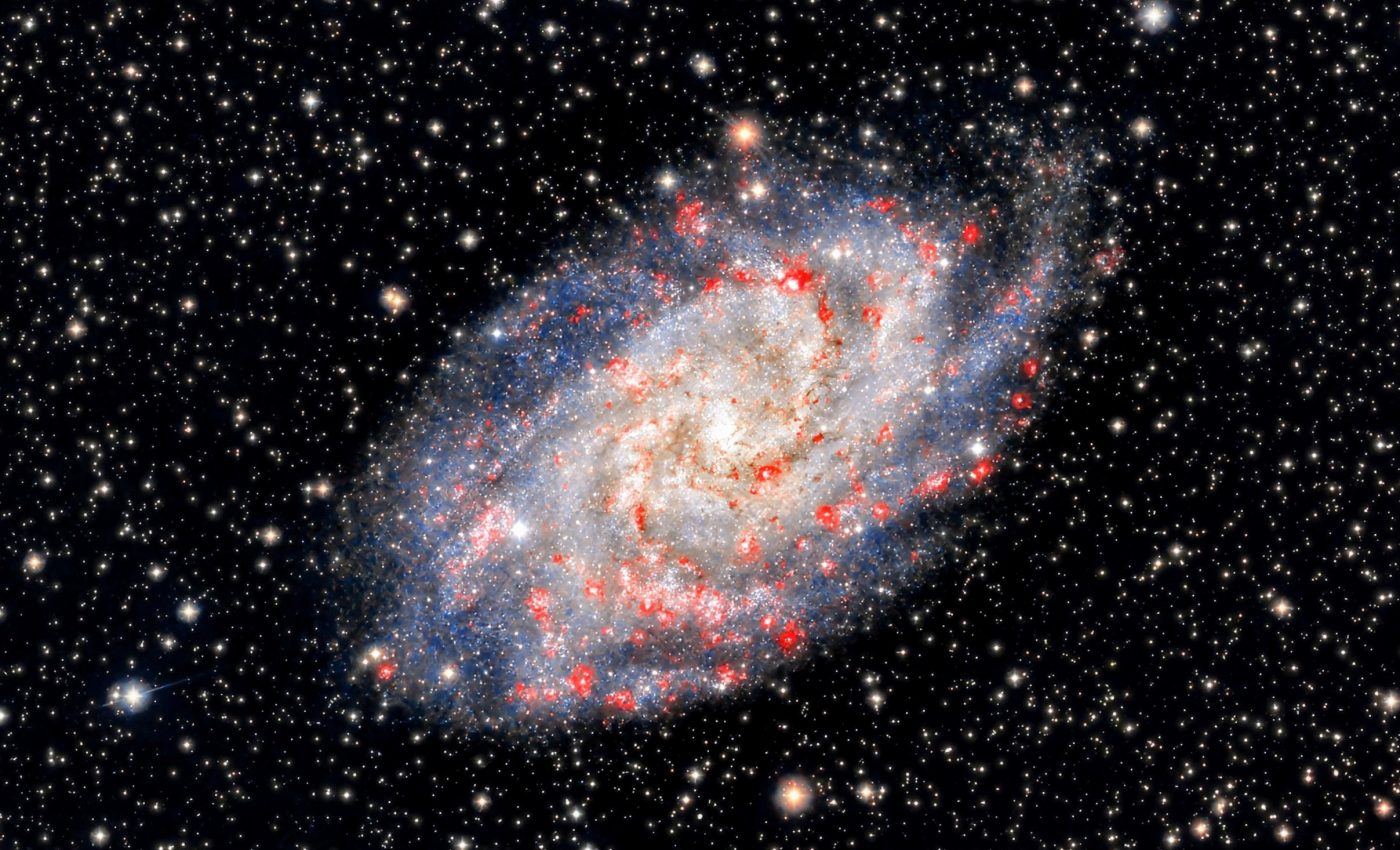
Messier 33: The unusual galaxy without a central black hole
Recently, the Hubble Space Telescope turned its gaze to the heart of a spiral galaxy named Messier 33 (M33), tucked away in the constellation of Triangulum.
This web of stars and nebulosity, about half the size of our own Milky Way, is the third largest galaxy in our Local Group.
Borne from the remarkable scientific endeavors of NASA and JP Dalcanton from the University of Washington, these insights help us grasp the magnetic allure of this celestial powerhouse.
The spectacle unveils a remarkable characteristic about M33 — it’s a hotbed nursery for stars. The galaxy’s star-forming activity outpaces the Andromeda galaxy, its neighbor, by ten-fold.
Inside the Messier 33 (M33) galaxy
The core of M33 is dominated by vibrant hues of pink and red glowing from regions of nebulosity. Amidst this colorful chaos, M33 shelters abundant dust and gas, the raw ingredients for star formation.
Add to this the presence of ionized hydrogen clouds or H-II regions, and we’re looking at a stellar breeding ground.
But unlike many galaxies whose star formations are often triggered by galactic collisions, M33’s firework display of starbirth plays out on a different stage.
The galaxy’s neat, ordered spiral arms imply minimal interaction with other galaxies, leading experts to believe that the star formation is the result of molecular cloud collisions within M33 itself.
The glow of countless stars
Take a closer gaze at the image, and you’ll see the star-studded graininess come to life. It isn’t mere noise; rather, it’s the glow of countless stars visible due to the proximity of M33.
This galaxy is one of fewer than a hundred close enough for the Hubble Space Telescope to analyze its individual stars, revealing their beauty and intricate details.
The view not only showcases the stars but also emphasizes the vastness and wonder of our universe.
No signs of a black hole
It may seem unusual to observe that M33, also known as the Triangulum Galaxy, lacks a central bulge and shows no signs of a supermassive black hole at its core.
This characteristic appears peculiar for a spiral galaxy, as most galaxies of this type typically host densely packed stars and supermassive black holes, making their absence noteworthy.
However, M33 belongs to a unique group of galaxies known as “pure disk galaxies.” In these galaxies, the classic structures associated with spiral formations are not present, highlighting the diverse nature of galaxy formation and evolution in the universe.
Understanding M33 aids astronomers in unraveling the complexities of galactic structures and the factors influencing their development.
Insights from the Messier 33 (M33) galaxy
As we contemplate the significance of M33, we also need to consider its role within the broader cosmic tapestry.
This galaxy provides a glimpse into a potentially primordial state of galactic evolution. Situated on the outskirts of the Local Group, M33 is in a dance of gravitational influence with its larger neighbors – Andromeda and the Milky Way.
Its relatively pristine environment, devoid of significant disturbances from galactic collisions, preserves clues about the early universe’s star formation processes.
Potential collision course
M33 galaxy’s peaceful existence might be heading for a dramatic turn. It seems set on a potential collision course with both the Milky Way and the Andromeda galaxy.
This image forms part of a broader survey of M33, aimed at refining our understanding of topics such as interstellar medium physics, star-formation processes, and stellar evolution.
As astronomers continue to focus their powerful telescopes on this cosmic wonder, they are steadily filling in the gaps of our knowledge about M33 and the vast expanse of space that it calls home.
With each new discovery, we come one step closer to understanding the intricacies of our universe and our place within it.
So as we contemplate this stunning image of M33 captured by the Hubble Space Telescope, let us also appreciate the remarkable journey that has brought us these insights and marvel at the mysteries yet to be revealed.
—–
Image Credit: NASA, ESA, M. Boyer (STScI), and J. Dalcanton (University of Washington); Processing: Gladys Kober (NASA/Catholic University of America)
—–
Like what you read? Subscribe to our newsletter for engaging articles, exclusive content, and the latest updates.
Check us out on EarthSnap, a free app brought to you by Eric Ralls and Earth.com.
—–














